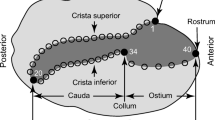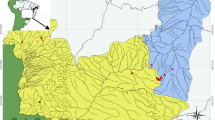Abstract
A comparative morphometric analysis was conducted on two European species of Echinostoma in order to examine the degree of the variability in the metrical characteristics of the adults and to assess their value in discriminating species. Adult E. miyagawai and E. revolutum, obtained experimentally, were compared using univariate and multivariate statistical analyses of 35 and 25 metrical characters, respectively. All subsets of worms of different ages represented homogeneous samples with respect to their morphometric characteristics; however, univariate analyses revealed significant differences in 22 and 23 variables between the corresponding age subsets of the two species, and it was found that the different allometric growth patterns contribute to this. The variables, body width at the posterior border of the ventral sucker, pharynx length and width, ovary length, testes length and width and length of the pre-ovarian region, exhibited isometric or positive allometric growth in E. miyagawai and negative allometry in E. revolutum. A cluster analysis based on 61 specimens and 25 variables separated E. revolutum and E. miyagawai unambiguously, producing an exact ordering of the specimens with respect to their identity and age. A forward stepwise discriminant analysis identified five variables (body width at the posterior border of ventral sucker, head collar width, length of oesophagus, width of ventral sucker and length of the pre-ovarian region) which yielded a 100% accurate classification of the two species. We suggest, therefore, that the morphometric characteristics of the adult worms should be used in studies attempting the identification of species or isolates of Echinostoma spp. More comparative data need to be gathered in order that the species boundaries within the ‘revolutum’ group be defined more accurately.
Similar content being viewed by others
References
Baršienė, J. (1993) The karyotypes of trematodes. Vil'nyus: Academia, 370 pp. (In Russian).
Baršienė, J. & Kiselienė, V. (1991) Karyological studies of trematodes within the genus Echinostoma. Acta Parasitologica Polonica, 36, 23–29.
Beaver, P. C. (1937) Experimental studies on Echinostoma revolutum (Frölich) a fluke from birds andmammals. Illinois Biological Monographs, 15, 96 pp.
Georgiev, B., Biserkov, V. & Genov, T. (1986) In toto staining method for cestodes with iron acetocarmine. Helminthologia, 23, 279–281.
Grabda-Kazubska, B. & Kiselienė, V. (1989) Chaetotaxy and excretory system of the cercaria of Echinoparyphium recurvatum (Linstow, 1873) (Digenea, Echinostomatidae). Acta Parasitologica Polonica, 34, 325–335.
Grabda-Kazubska, B. & Kiselienė, V. (1991) The life cycle of Echinoparyphium mordwilkoi Skrjabin, 1915 (Trematoda, Echinostomatidae). Acta Parasitologica Polonica, 36, 167–173.
Hsu, K. C., Lie, K. J. & Basch, P. F. (1968) The life history of Echinostoma rodriguesi sp. n. (Trematoda: Echinostomatidae). The Journal of Parasitology, 54, 333–339.
Fried, B., Mueller, T. J. & Frazer, B. A. (1997) Observations on Echinostoma revolutum and Echinostoma trivolvis in single and concurrent infections in domestic chicks. International Journal for Parasitology, 27, 1319–1322.
Humphries, J. E., Reddy, A. & Fried, B. (1997) Infectivity and growth of Echinostoma revolutum (Frölich, 1802) in the domestic chick. International Journal for Parasitology, 27, 129–130.
Jeyarasasingam, U., Heyneman, D., Hok-Kan-Lim & Mansour, N. (1972) Life cycle of a new echinostome from Egypt, Echinostoma liei sp. nov. (Trematoda: Echinostomatidae). Parasitology, 65, 203–222.
Kanev, I. (1981) Studies on the species composition of the echinostomatids (Trematoda) in Bulgaria. VI. Establishment of an echinostome with the features of Echinostoma barbosai Lie et Basch, 1966. Khelmintologiya, 12, 36–47 (In Bulgarian).
Kanev, I. (1980) Studies on the species belonging of echinostomes (Trematoda) in Bulgaria. IV. On the development and ecology of Echinostoma audyi] Lie et Umathevy, 1965. Khelmintologiya, 9, 39–50 (In Bulgarian).
Kanev, I. (1985) [On the morphology, biology, ecology and taxonomy of Echinostoma revolutum group (Trematoda: Echinostomatidae: Echinostoma)] Thesis, Bulgarian Academy of Sciences, Sofia, 467 pp. (In Bulgarian).
Kanev, I. (1994) Life-cycle, delimitation and redescription of Echinostoma revolutum (Frölich, 1802) (Trematoda: Echinostomatidae). Systematic Parasitology, 28, 125–144.
Kanev, I., Dimitrov, V., Radev, V. & Fried, B. (1995a) Redescription of Echinostoma trivolvis (Cort, 1914) with a discussion of its identity. Systematic Parasitology, 32, 61–70.
Kanev, I., Fried, B., Dimitrov, V. & Radev, V. (1995b) Redescription of Echinostoma jurini (Skvortzov, 1924) with a discussion of its identity and characteristics. Annalen des Naturhistorischen Museums in Wien, 97B, 37–53.
Kiselienė, V. & Grabda-Kazubska, B. (1990) Echinoparyphium pseudorecurvatum sp. n. (Trematoda, Echinostomatidae) and its life cycle. Acta Parasitologica Polonica, 35, 285–295.
Kostadinova, A. (1995) Echinostoma echinatum (Zeder, 1803) sensu Kanev (Digenea: Echinostomatidae): a note of caution. Systematic Parasitology, 32, 23–26.
Kostadinova, A., Gibson, D. I., Biserkov, V. & Chipev, N. (In press) Re-validation of Echinostoma miyagawai Ishii, 1932 (Digenea: Echinostomatidae) on the basis of experimental completion of its life-cycle. Systematic Parasitology.
Kosupko (1971a) [Criteria of the species Echinostoma revolutum, demonstrated on experimental material.] In: Sbornik Rabot po Gel'mintologii posvyashchen 90-letiyu so dnya rozhdeniya Akademika K.I. Skrjabina. Moscow: 'Kolos', pp. 167–175 (In Russian).
Kosupko, G. A. (1971b) New data in the bioecology and morphology of Echinostoma revolutum and E. miyagawai (Trematoda: Echinostomatidae). Byulleten' Vsesoyuznogo Instituta Gel'mintologii imeni K.I. Skrjabina, 5, 43–49 (In Russian).
Lie, K. J. & Kanev, I. (1983) Identification and distribution of Echinostoma lindoense, E. audyi and E. revolutum (Trematoda; Echinostomatidae). Zeitschrift für Parasitenkunde, 69, 223–227.
Mouahid, A. & Moné, H. (1988) Echinoparyphium elegans (Looss, 1899) (Digenea: Echinostomatidae): the life-cycle and redescription of the adult with a revision of the 43-spined members of the genus Echinoparyphium. Systematic Parasitology, 12, 149–157.
Našincová, V. (1986) Contribution to the distribution and the life history of Echinostoma revolutum in Central Europe. Věstník Československé Společnosti Zoologické, 50, 70–80.
Našincová, V. (1991) The life cycle of Echinostoma bolschewense (Kotova, 1939) (Trematoda: Echinostomatidae). Folia Parasitologica, 38, 143–154.
Nasir, P. (1960) Studies on the life history of Echinostoma nudicaudatum n. sp. (Echinostomatidae: Trematoda). The Journal of Parasitology, 46, 833–847.
Skrjabin, K. I. & Bashkirova, E. Y. (1956) Family Echinostomatidae. In: Skrjabin K. I. (Ed). [Trematodes of animals and man.] Moscow: Izdatel'stvo Akademii Nauk SSSR, 12, 501–546.
Sokal, R. R. & Rohlf, F. J. (1981) Biometry. The principles and practice of statistics in biological research. (2nd ed.). New York: W. H. Freeman & Co, 859 pp.
SPSS Inc. (1996) SYSTAT 7.0. Data, graphics, statistics, new statistics and command reference.
Vasilev, I., Kanev, I., Svietlicovski, M. & Busta J. (1982) Establishment of an echinostome with the features of Echinostoma lindoense Sandground et Bonne, 1940 (Echinostomatidae: Trematoda) in Poland and Czechoslovakia. Khelmintologiya, 13, 12–21 (In Bulgarian).
Vasilev, I. & Kanev, I. (1981) Studies on echinostomatids (Trematoda) species composition in Bulgaria. V. On the development and ecology of Echinostoma lindoense Sandground et Bonne, 1940. Khelmintologiya, 11, 39–50 (In Bulgarian).
Yamaguti, S. (1971) Synopsis of digenetic trematodes of vertebrates. Tokyo: Keigaku, 1,074 pp.
Author information
Authors and Affiliations
Rights and permissions
About this article
Cite this article
Kostadinova, A., Gibson, D., Biserkov, V. et al. A quantitative approach to the evaluation of the morphological variability of two echinostomes, Echinostoma miyagawai Ishii, 1932 and E. revolutum (Frölich, 1802), from Europe. Syst Parasitol 45, 1–15 (2000). https://doi.org/10.1023/A:1006232612469
Issue Date:
DOI: https://doi.org/10.1023/A:1006232612469




